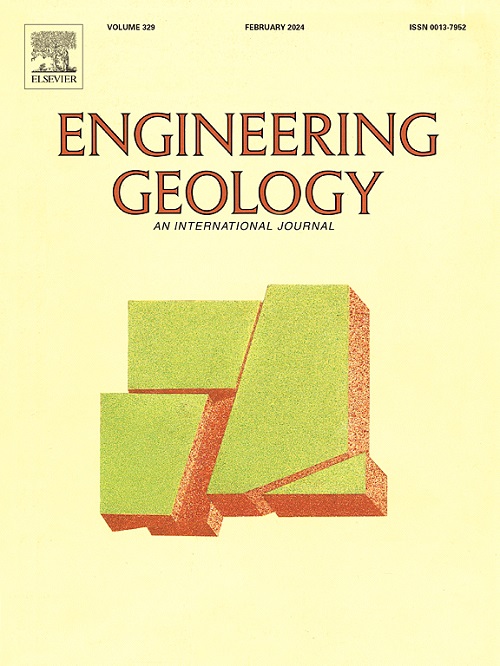由中和炉渣组成的三层垃圾填埋场覆盖系统在极端气候条件下的防渗性能和隔氧性能
IF 6.9
1区 工程技术
Q1 ENGINEERING, GEOLOGICAL
引用次数: 0
摘要
对于酸性工业固体废物,需要一种有效的覆盖系统来减少雨水渗透和氧气侵入,从而减少废物产生的酸性矿井排水(AMD)。根据 "废物保护废物 "的新理念,我们提出了一种在传统毛细管屏障覆盖层底部使用低渗透性中和矿渣(简称 TCNS)的三层覆盖层。本研究通过实验室柱试验和数值模拟,研究了 TCNS 在极端气候条件下的防渗性能和阻氧性能。结果表明,在极湿或极干条件下,中和渣(NS)层的含水量都保持稳定(即变化小于 0.02)。在极度潮湿条件下(即相当于 50 年一遇的暴雨),覆盖层底部未观察到渗水现象;在极度干燥条件下,氧气扩散受到严重阻碍,例如,经过 208 天的柱状试验后,裸露(即未覆盖)废石的 AMD 中的 SO42- 浓度是 TCNS 覆盖废石的 4.6 倍。考虑到两种实际气候条件(即潮湿和干旱)的数值模拟结果表明,TCNS 能有效控制渗水和氧气侵入。NS 层的饱和渗透系数(ks)和初始饱和度(Se)对 TCNS 的性能有显著影响,即降低 ks 或提高 Se 可有效降低渗水量和氧气通量。总之,即使在极端气候条件下,TCNS 也是控制渗水和氧气侵入的有效屏障。因此,它能有效减少 AMD 渗漏,从而减少地下水污染等地质灾害。本文章由计算机程序翻译,如有差异,请以英文原文为准。
Anti-seepage performance and oxygen barrier performance of the three-layered landfill cover system comprising neutralized slag under extreme climate conditions
For acidic industrial solid wastes, an effective cover system is needed to reduce the rainwater infiltration and oxygen intrusion, thus reducing the generation of acid mine drainage (AMD) from wastes. A three-layered cover using low-permeability neutralized slag (abbreviated as TCNS) at the bottom of the traditional capillary barrier cover is proposed, in line with the novel concept of “waste protecting waste”. This study investigates the anti-seepage performance and oxygen barrier performance of TCNS under extreme climate conditions, through laboratory column test and numerical simulations. The results show that the water content of the neutralized slag (NS) layer remained stable (i.e., changed by less than 0.02) under either extremely wet condition or extremely dry condition. Under extremely wet condition (i.e., heavy rainfall corresponding to a 50-year return period), no water percolation was observed at the cover bottom; under extremely dry conditions, oxygen diffusion was greatly impeded, e.g., after 208 days of column test, the SO42− concentration in the AMD of the exposed (i.e., uncovered) waste rock was 4.6 times higher than that of the waste rock covered by TCNS. Numerical simulations considering two realistic climate conditions (i.e., humid and arid) showed that TCNS were effective in controlling water percolation and oxygen intrusion. The saturated permeability coefficient (ks) and initial saturation degree (Se) of the NS layer have significant effects on the performance of TCNS, i.e., decreasing ks or increasing Se can effectively reduce the water percolation and oxygen flux. In sum, TCNS is an effective barrier for controlling water percolation and oxygen intrusion, even in extreme climate conditions. Consequently, it can effectively minimize AMD leakage and thus reduce geological disasters such as groundwater contamination.
求助全文
通过发布文献求助,成功后即可免费获取论文全文。
去求助
来源期刊

Engineering Geology
地学-地球科学综合
CiteScore
13.70
自引率
12.20%
发文量
327
审稿时长
5.6 months
期刊介绍:
Engineering Geology, an international interdisciplinary journal, serves as a bridge between earth sciences and engineering, focusing on geological and geotechnical engineering. It welcomes studies with relevance to engineering, environmental concerns, and safety, catering to engineering geologists with backgrounds in geology or civil/mining engineering. Topics include applied geomorphology, structural geology, geophysics, geochemistry, environmental geology, hydrogeology, land use planning, natural hazards, remote sensing, soil and rock mechanics, and applied geotechnical engineering. The journal provides a platform for research at the intersection of geology and engineering disciplines.
 求助内容:
求助内容: 应助结果提醒方式:
应助结果提醒方式:


